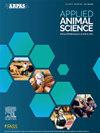Effects of displacing modified distillers grains with dry-rolled corn in a totally mixed ration on performance of growing beef steers consuming cornstalk residue from different harvest methods
IF 1.5
Q3 AGRICULTURE, DAIRY & ANIMAL SCIENCE
引用次数: 0
Abstract
Objective
The objective was to determine the effects of displacing modified distillers grains with dry-rolled corn in a TMR for steers consuming corn residue from 2 baling methods on growth of beef steers.
Materials and Methods
Crossbred beef steers (n = 120; initial BW = 281; SD = 15 kg) were assigned in a randomized complete block design with a 4 × 3 factorial treatment arrangement (10 steer/treatment). Factors included proportion of modified distillers grains with solubles (MDGS) and dry-rolled corn (DRC; 100:0, 80:20, 60:40, and 40:60 respectively) in the concentrate, and 3 forages; either high quality (70% brome hay and 30% sorghum silage; HQ) or corn residue from 2 baling methods. Corn residue was baled as a conventional rake and bale system (RB), or by disengaging the spreader on the combine and baling the tailings (DS). Steers were fed diets as a TMR (60:40 roughage:concentrate) individually for 84 d making steer the experimental unit.
Results and Discussion
A significant interaction was observed for DMI. At each proportion of MDGS in the concentrate, DMI for HQ (8.7, 9.2, 9.4, 8.5 kg/d) was greater than for RB (6.0, 5.5, 5.2, 5.6 kg/d) and DS (5.5, 5.0, 5.5, and 4.8 kg/d), which were not different. The interaction was due to the magnitude of the difference between intakes at the 40% MDGS level. Steers fed HQ had greater ending BW (393 kg) and ADG (1.31 kg/d) than those in RB (350 kg; 0.81 kg/d) and DS (346 kg; 0.76 kg/d). The G:F was not different for HQ, RB, and DS (0.148, 0.146, 0.149, respectively). As MDGS:DRC ratio decreased, ending BW (369, 365, 362, 356 kg), ADG (1.03,0.98, 0.96, 0.87 kg/d), and G:F (0.153, 0.153, 0.145, 0.139) decreased linearly.
Implications and Applications
Disengaging the spreader on the combine could result in similar animal performance as raking and baling for producers feeding crop residues. Decreasing the ratio of MDGS to DRC fed to growing steers fed a forage-based TMR reduced ending BW and ADG suggesting the energy supplied by MDGS cannot be replaced with DRC.
在完全混合日粮中用干卷玉米代替改性酒糟对食用不同收获方式玉米秸秆残渣的生长肉牛生产性能的影响
目的:研究在食用两种打捆方式玉米渣的肉牛TMR试验中,用干卷玉米代替改性酒糟对肉牛生长的影响。材料与方法杂交肉牛(n = 120;初始体重= 281;SD = 15 kg)被分配到随机完全区组设计中,采用4 × 3因子处理安排(10头/处理)。影响因素包括可溶物(mdg)和干卷玉米(DRC;分别为100:0、80:20、60:40和40:60),3种饲料;要么是优质(70%的溴干草和30%的高粱青贮);HQ)或玉米残渣从两种打捆方法。采用常规耙捆系统(RB)对玉米渣进行捆扎,或脱离联合收割机上的播种机对尾矿进行捆扎。饲喂TMR(60:40粗料:精料)试验饲粮84 d。结果和讨论观察到DMI有显著的相互作用。在mdg各配比下,HQ的DMI(8.7、9.2、9.4、8.5 kg/d)均大于RB(6.0、5.5、5.2、5.6 kg/d)和DS(5.5、5.0、5.5、4.8 kg/d),两者差异不显著。这种相互作用是由于在40%千年发展目标水平上的摄入量差异很大。饲喂HQ的肉牛末重(393 kg)和平均日增重(1.31 kg/d)高于饲喂RB的肉牛(350 kg;0.81 kg/d)和DS (346 kg;0.76公斤/ d)。黄芪、黄芪、黄芪的G:F差异不显著(分别为0.148、0.146、0.149)。随着mdg:DRC比值的降低,末重(369、365、362、356 kg)、平均日增重(1.03、0.98、0.96、0.87 kg/d)和G:F(0.153、0.153、0.145、0.139)呈线性下降。启示和应用在联合收割机上解除播种机的操作,对饲养作物残茬的生产者来说,其动物生产性能与耙垛和打捆相似。减少以饲料为基础的TMR喂养的生长牛的mdg与DRC的比例降低了末重和平均日增重,这表明mdg提供的能量不能被DRC所取代。
本文章由计算机程序翻译,如有差异,请以英文原文为准。
求助全文
约1分钟内获得全文
求助全文

 求助内容:
求助内容: 应助结果提醒方式:
应助结果提醒方式:


